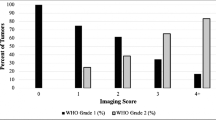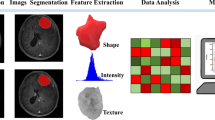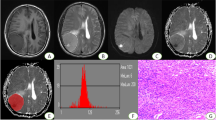Abstract
High-grade (World Health Organization grades II and III) meningiomas grow aggressively and recur frequently, resulting in a poor prognosis. Assessment of tumor malignancy before treatment initiation is important. We attempted to determine predictive factors for high-grade meningioma on magnetic resonance (MR) imaging before surgery. We reviewed 65 meningiomas (39 cases, benign; 26 cases, high-grade) and assessed four factors: (1) tumor–brain interface (TBI) on T1-weighted imaging (T1WI), (2) capsular enhancement (CapE), i.e., the layer of the tumor–brain interface on gadolinium-enhanced T1WI (T1Gd), (3) heterogeneity on T1Gd, and (4) tumoral margin on T1Gd. All four factors were useful in distinguishing high-grade from benign meningiomas, according to univariate analysis. On multivariate regression analysis, unclear TBI and heterogeneous enhancement were independent predictive factors for high-grade meningioma. In meningiomas with an unclear TBI and heterogeneous enhancement, the probability of high-grade meningioma was 98%. Our data suggest that this combination of factors obtained from conventional sequences on MR imaging may be useful to predict high-grade meningioma.

Similar content being viewed by others
References
Bondy M, Ligon BL (1996) Epidemiology and etiology of intracranial meningiomas: a review. J Neurooncol 29:197–205
Kuratsu J, Kochi M, Ushio Y (2000) Incidence and clinical features of asymptomatic meningiomas. J Neurosurg 92:766–770. doi:10.3171/jns.2000.92.5.0766
Perry A, Louis DN, Scheithauer BW, Budka H, Von Deimling A (2007) Meningiomas. In: Louis DN, Ohgaki H, Wiestler OD, Cavenee WK (eds) WHO classification of tumours of the central nervous system, 4th edn. IARC, Lyon, pp 164–172
Pearson BE, Markert JM, Fisher WS, Guthrie BL, Fiveash JB, Palmer CA, Riley K (2008) Hitting a moving target: evolution of a treatment paradigm for atypical meningiomas amid changing diagnostic criteria. Neurosurg Focus 24:E3. doi:10.3171/FOC/2008/24/5/E3
Willis J, Smith C, Ironside JW, Erridge S, Whittle IR, Everington D (2005) The accuracy of meningioma grading: a 10-year retrospective audit. Neuropathol Appl Neurobiol 31:141–149. doi:10.1111/j.1365-2990.2004.00621.x
Nakasu S, Nakasu Y, Nakajima M, Matsuda M, Handa J (1999) Preoperative identification of meningiomas that are highly likely to recur. J Neurosurg 90:455–462. doi:10.3171/jns.1999.90.3.0455
Kasuya H, Kubo O, Tanaka M, Amano K, Kato K, Hori T (2006) Clinical and radiological features related to the growth potential of meningioma. Neurosurg Rev 29:293–296 (discussion 296–297). doi:10.1007/s10143-006-0039-3
Nakamura M, Roser F, Michel J, Jacobs C, Samii M (2003) The natural history of incidental meningiomas. Neurosurgery 53:62–70 (discussion 70–61)
Hashiba T, Hashimoto N, Maruno M, Izumoto S, Suzuki T, Kagawa N, Yoshimine T (2006) Scoring radiologic characteristics to predict proliferative potential in meningiomas. Brain Tumor Pathol 23:49–54. doi:10.1007/s10014-006-0199-4
Ildan F, Tuna M, Gocer AP, Boyar B, Bagdatoglu H, Sen O, Haciyakupoglu S, Burgut HR (1999) Correlation of the relationships of brain-tumor interfaces, magnetic resonance imaging, and angiographic findings to predict cleavage of meningiomas. J Neurosurg 91:384–390. doi:10.3171/jns.1999.91.3.0384
Nakasu S, Hirano A, Llena JF, Shimura T, Handa J (1989) Interface between the meningioma and the brain. Surg Neurol 32:206–212
Nakasu S, Nakasu Y, Matsumura K, Matsuda M, Handa J (1990) Interface between the meningioma and the brain on magnetic resonance imaging. Surg Neurol 33:105–116
Takeguchi T, Miki H, Shimizu T, Kikuchi K, Mochizuki T, Ohue S, Ohnishi T (2003) Evaluation of the tumor-brain interface of intracranial meningiomas on MR imaging including FLAIR images. Magn Reson Med Sci 2:165–169
Takeguchi T, Miki H, Shimizu T, Kikuchi K, Mochizuki T, Ohue S, Ohnishi T (2003) Prediction of tumor-brain adhesion in intracranial meningiomas by MR imaging and DSA. Magn Reson Med Sci 2:171–179
Ayerbe J, Lobato RD, de la Cruz J, Alday R, Rivas JJ, Gomez PA, Cabrera A (1999) Risk factors predicting recurrence in patients operated on for intracranial meningioma. A multivariate analysis. Acta Neurochir (Wien) 141:921–932
Ildan F, Erman T, Gocer AI, Tuna M, Bagdatoglu H, Cetinalp E, Burgut R (2007) Predicting the probability of meningioma recurrence in the preoperative and early postoperative period: a multivariate analysis in the midterm follow-up. Skull Base 17:157–171. doi:10.1055/s-2007-970554
Hosmer DW, Hosmer T, Le Cessie S, Lemeshow S (1997) A comparison of goodness-of-fit tests for the logistic regression model. Stat Med 16:965–980. doi:10.1002/(SICI)1097-0258(19970515)16:9<965:AID-SIM509>3.0.CO;2-O
Spagnoli MV, Goldberg HI, Grossman RI, Bilaniuk LT, Gomori JM, Hackney DB, Zimmerman RA (1986) Intracranial meningiomas: high-field MR imaging. Radiology 161:369–375
Nakasu S, Nakajima M, Matsumura K, Nakasu Y, Handa J (1995) Meningioma: proliferating potential and clinicoradiological features. Neurosurgery 37:1049–1055
Yoshida K, Onozuka S, Kawase T, Ikeda E (2000) Lateral ventricular meningioma encapsulated by the dura-like membrane. Neuropathology 20:56–59
Dietemann JL, Heldt N, Burguet JL, Medjek L, Maitrot D, Wackenheim A (1982) CT findings in malignant meningiomas. Neuroradiology 23:207–209
Durand A, Labrousse F, Jouvet A, Bauchet L, Kalamarides M, Menei P, Deruty R, Moreau JJ, Fevre-Montange M, Guyotat J (2009) WHO grade II and III meningiomas: a study of prognostic factors. J Neurooncol 95:367–375. doi:10.1007/s11060-009-9934-0
Vassilouthis J, Ambrose J (1979) Computerized tomography scanning appearances of intracranial meningiomas. An attempt to predict the histological features. J Neurosurg 50:320–327. doi:10.3171/jns.1979.50.3.0320
Buhl R, Nabavi A, Wolff S, Hugo HH, Alfke K, Jansen O, Mehdorn HM (2007) MR spectroscopy in patients with intracranial meningiomas. Neurol Res 29:43–46
Toh CH, Castillo M, Wong AM, Wei KC, Wong HF, Ng SH, Wan YL (2008) Differentiation between classic and atypical meningiomas with use of diffusion tensor imaging. Am J Neuroradiol 29:1630–1635. doi:10.3174/ajnr.A1170
Yue Q, Isobe T, Shibata Y, Anno I, Kawamura H, Yamamoto Y, Takano S, Matsumura A (2008) New observations concerning the interpretation of magnetic resonance spectroscopy of meningioma. Eur Radiol 18:2901–2911. doi:10.1007/s00330-008-1079-6
Conflict of interest
The authors declare that they have no conflict of interest.
Author information
Authors and Affiliations
Corresponding author
Rights and permissions
About this article
Cite this article
Kawahara, Y., Nakada, M., Hayashi, Y. et al. Prediction of high-grade meningioma by preoperative MRI assessment. J Neurooncol 108, 147–152 (2012). https://doi.org/10.1007/s11060-012-0809-4
Received:
Accepted:
Published:
Issue Date:
DOI: https://doi.org/10.1007/s11060-012-0809-4




